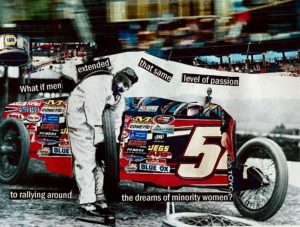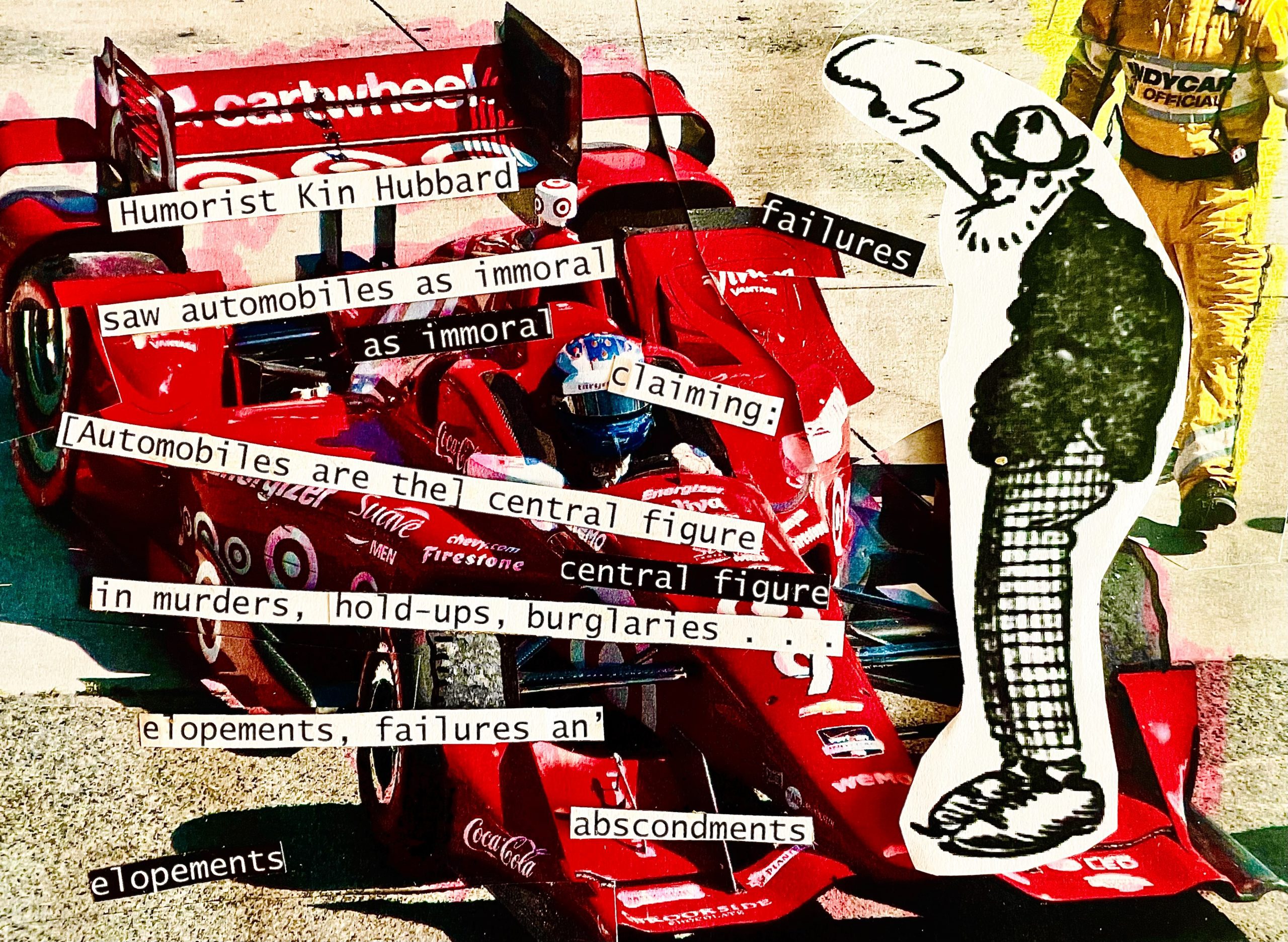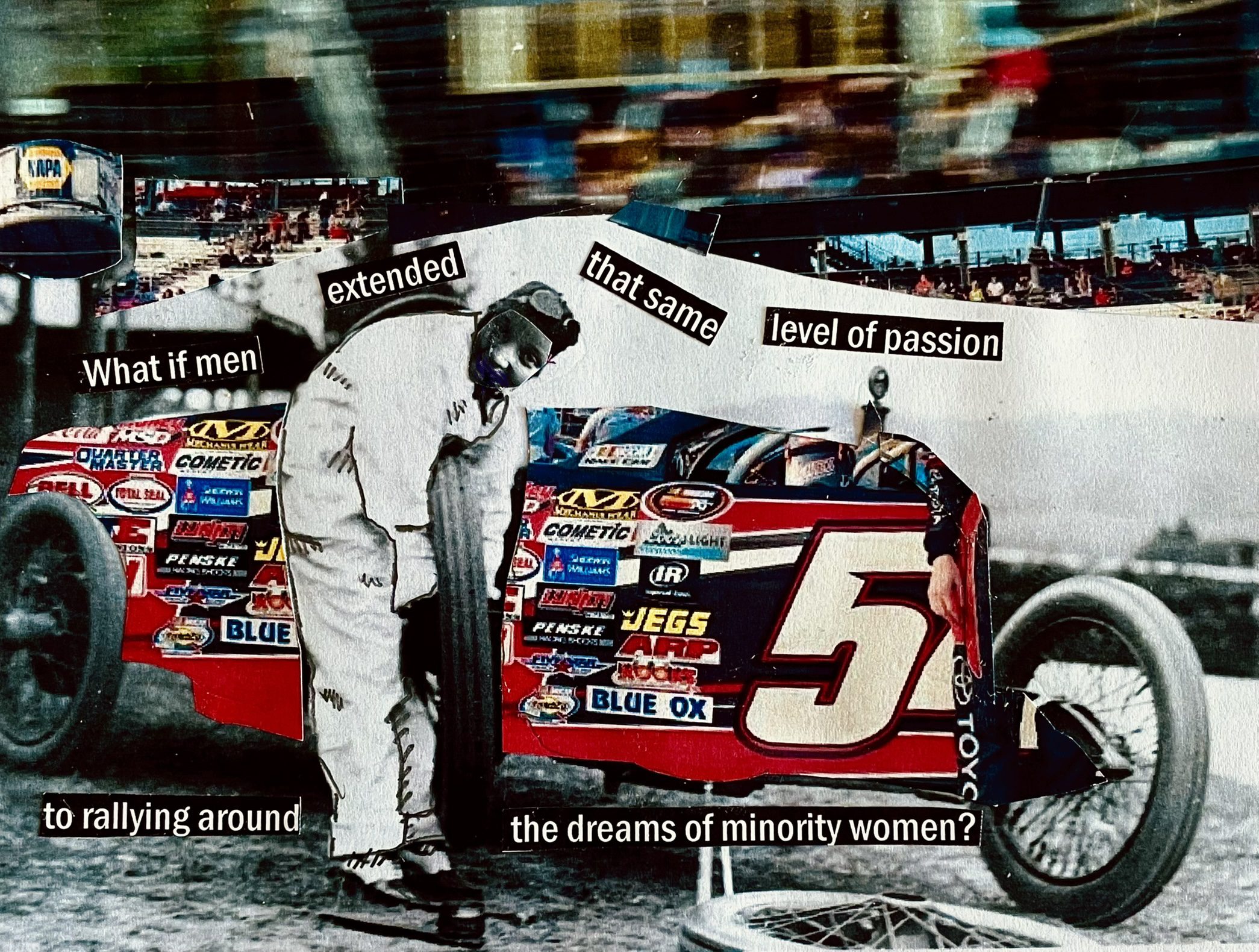
Before Indianapolis became known as the “Racing Capital of the World,” mainly for holding the iconic Indianapolis 500, the world’s largest single-day sporting event, many Hoosiers viewed cars with skepticism. One Kokomo, Indiana, resident filed a lawsuit in 1901 arguing that automobiles were too dangerous for the city’s streets. Cars and their loud engines scared horses and pedestrians! To address complaints, in 1905 Hoosier legislators took their first step toward regulation with a city traffic speed limit of 8 mph. Humorist Kin Hubbard, saw automobiles as immoral, claiming they let loose the criminal tendencies of the era: “[Automobiles are the] central figure in murders, hold-ups, burglaries, accidents, elopements, failures an’ abscondments.” He was in good company: when back roads became lovers’ lanes in the 1920s, church leaders and Ku Klux Klan members decried backseat sex. One Muncie judge even vilified automobiles as “a house of prostitution on wheels.” They feared cars were a step backward for civilization.
In 2022, I attended the 106th running of the Indianapolis 500, and watched cars hurtle past at 220 mph—fast enough to cover a football field in nine tenths of a second. Over 325,000 fans cheered louder than the engines themselves. The Indianapolis Motor Speedway’s size is misleading when viewed on television, and it’s only from within the track that you can even start to appreciate the enormous 2.5-mile banked oval. I’m well acquainted with the Speedway, having been an Indianapolis 500 Festival Princess in college and from attending the race many times. My dad has attended 40 races since moving to Indiana from England in the 1970s and each year my family goes in a big group. What makes us different from most race fans is that we are Indian. Data collected from an IndyCar survey found there are 69 million self-declared IndyCar fans worldwide, of which 79% are white and male (66%).
Thanks to the determination of visionary white men who wanted to give manufacturers a place to test out cars, and then men who kept the track alive through two World Wars and the Great Depression, the Indianapolis Motor Speedway became a site of extraordinary feats—where drivers, crews, and cars are pushed beyond limits once believed unattainable.
Halfway through the race, at lap 100 of 200, I decide to leave my family’s group of 20 in the bleachers and venture where I’ve never gone before: the infield, known for its partying. I’m visiting home from where I now live in New York. The last time I attended the race, I wanted to explore the infield, and was told not to by male relatives because of the long walk and because my family would worry about me. A female relative had wanted to go with me, and we sat through the rest of the race glum, aware of our place. It had taken a lot of courage to even ask. I was working on an essay about the 500 and wanted more material, plus the chance to have an adventure. As an Indian daughter, I’m used to these restrictions, but on this day, I want to be a pioneer for what women can do at the race. This year, I feel bolder. I deserve to have an infield experience; screw others who say it’s not safe or only for men.
It took decades for women at the race to have access to all areas. In 1939, when Louis Meyer had an accident on the backstretch, June Meyer, his wife expressed disbelief when she ran to the garage, and they let her in. Back then, driver’s wives weren’t allowed into the pits because they were considered bad luck and were relegated to the grandstands. Then, in 1974, a driver’s wife was let into the pits, and her husband won, paving the way for other women. In 1977, Janet Guthrie became the first woman to start an Indy 500, and the four women who raced in 2010 and 2011 have made an impact, but that progress has slowed. The 2020 race was the first without at least one female driver since 1999 and this 2022 race was the second shutout in three years. Only one woman of color has raced in the 500.
So, I set off, each step a victory. Everyone knows to walk fast beneath the bleachers because people dump their coolers and food. The path is littered with chewed chicken bones, and I feel as though I’m in the lair of a sleeping prehistoric monster. The sunshine plays beautifully with the gold hue of the light beer sprinkled from above.
In the area just beyond the bleachers of Turn 3 is a golf course. First, I compliment four men near a bunker on their matching head-to-toe checkered flag suits. One is lying in the grass like a vampire in a coffin as his friend takes his picture. “We like your shirt!” one tells me. “What is that? A cat flying on a piece of pizza in outer space?”
“Yeah, it was between this and an intergalactic cat donut shirt.” We then bond over Amazon’s crazy clothes selection.
As I continue down the paved walking path toward Turn 4, where the entrance to the infield is located, I see a Reggie Miller jersey, a group with tank tops that read “I’ve got a checkered past,” “I know what you did for a Klondike Bar,” and my personal favorite: “Attention Kmart shoppers.” A beefy bruh with a Tony-Soprano-checking-the-mail-saunter passes me, wearing an American flag shirt unbuttoned to the start of his gigantic belly, a cigar in his mouth. His majestic contentedness turns heads.
From the path, I see a white woman stumble to the ground in Turn 4’s long bathroom line. Her shirt reads “My drinking has a racing problem.” She’s helped up by another white woman wearing a “Drinks well with others” tank. I wish I was on their level, but because I wanted to explore, I’ve only had half a White Claw.
To my right, I notice kids playing on a putting green and a man standing in the middle, with his back turned. Then I realize he’s peeing and either he’s too drunk to notice the kids by his legs or he doesn’t care.
At the entrance of the tunnel leading beneath the track to the infield is a guy who is too drunk to roll his cooler in a straight line and every few feet, it teeters dangerously. The walk through the tunnel makes me feel so badass, being under the track for the first time, close to danger and excitement. An ambulance leaving the infield passes me, probably carrying a heat stroke sufferer or a victim of alcohol poisoning.
Flames erupt over the track’s concert stage, known as the Snake Pit, as I leave the tunnel. At about 100 meters away, I can’t make out the song, but I know Steve Aoki and Martin Garrix are performing. I enter the grassy infield during lap 111. Here the cars are closer to eye-level, smears of fluorescence whipping around the track, their roaring engines vibrating through me. I made it. The video board, which I’ve only observed from several hundred meters away in the bleachers, looms, and I almost feel shy finally in its presence. The commentator’s booming voice echoes over the vast grounds. A sea of trash including everything from deserted coolers to half-eaten pork tenderloin sandwiches to condom wrappers litters the field. The smell of burning rubber mixes with the scent of stale beer, cigarette smoke, urine, shit, and sweat.
At the heart of the racetrack exists the behavior our culture tries to hide, a place where everything terrible resides, where regressive behavior and values are celebrated. The infield is a bastion of lawlessness, where people act like animals and there’s too much debauchery going on for the police to arrest all wrong-doing. Though I don’t see any arrests occurring right then, it’s not hard to guess the charges: nudity, underage drinking, possession of marijuana, etc. People cross paths under an expansive sky. It’s thrilling to be around these new people instead of the older, mostly rule-following regulars with their families that I see where we sit at Turn 3. Many of the infield-ies are covered in mud, I’m assuming from the mosh pit? From mud wrestling? Next to me stands a woman in a “Fuck 2020” tank. A shirtless man in a mullet wig and jorts salutes the passing cars with a beer bong, a woman in a checkered flag swimsuit at his side.
The infield is our country laid bare—who we are when the guise of respectability dissipates. “Run the damn ball” walks with “I Shaved My Balls For This” toward some tents, as “Free Cock Rides” cheers solo cups with “Certified Dick.” Soooo much dick in case I forget where I am: a testosterone-fueled event. Thousands of people are partying, and of those I see around me, most are young men.
Then, I notice a teenage boy in a “Let’s Go Brandon” tank, probably inspired by what the adults in his life find funny. The phrase cropped up in October 2021 following a NASCAR race at the Talladega Superspeedway in Alabama. As a driver was interviewed, the crowd behind him chanted. The reporter suggested that the crowd was saying, “Let’s go, Brandon!” However, the crowd was shouting, “Fuck Joe Biden!” Now it’s taken off as a right-wing slogan.
It’s just a dumb shirt, I think. He’s harmless. But after he passes me, I realize I’ve been holding my breath, part of me assuming he wouldn’t be welcoming of a brown woman in his infield.
A young guy with a “Biden Sucks, Kamala Swallows” shirt walks by me, chanting “Freedom,” and “America.” A guy in a “Joe and the Ho Gotta Go” shirt enthusiastically joins in.
I wasn’t naïve to think I wouldn’t feel uncomfortable on my infield journey, but suddenly I feel shocked, gutted, like I’ve careened into a wall at 200mph and wrecked.
While I welcome critique of Harris’ policy positions—as I do for any other politician—I’m reminded of how many dehumanize her. The idea of a woman of color as vice president triggers a rage response from white racists who long for a return to a past of white male domination over women of color. The first line of an op-ed published on a conservative site reads, “It is no secret but public knowledge that Kamala Harris slept her way up into California political life by being a very public escort and mattress…” DeAnna Lorraine, a former Republican congressional candidate, tweeted that Harris “belongs on the Real Housewives of Atlanta, not negotiating with world leaders” and her “facial expressions are juvenile & beneath the dignity of the office of VP.” Stereotypes are weaponized against her in a way they aren’t for white people. One Newsweek article claimed that Harris might not qualify to be vice president due to her parents’ immigration (a total farce). After a 2020 debate, Trump campaign adviser Harlan Hill tweeted that Harris is an “insufferable lying bitch.” After the debate, Trump called Harris a “monster” twice, and said she was “totally unlikable.” The truth is that they fear Kamala Harris, a woman of color, is a step backward for America.
How Harris is treated sends a message to other black and brown people who strive for leadership roles. Unfortunately, people rarely face retribution for attacks verbal or physical against women of color, indicating that our society would rather maintain racism and sexism instead of denouncing it. It’s 2022, and women of color are still stuck in the slow lane.
Thirty-three male drivers drive circles around me. The Speedway is a celebration of over a century of innovation. In 1909, in the span of just 63 days, 3.2 million paving bricks were laid at the track. The first rearview mirror ever used on a vehicle was rigged by the first winner of the race. In 1922, Barney Oldfield ordered a harness for his race car and by the early 1960s, front seat belts were mandatory in U.S. vehicles. Car designer Harry Miller introduced four-wheel disc brakes to Indy cars in the 1930s, something that became available to Americans after the end of World War II. In that same decade, Miller created an all-wheel drive racer to combat the slippery surface of the track. Over the years, the Indy 500 has also been used as a test lab for tire compounds, structure, and tread design. Look at what men can accomplish when they want to actualize something.
But how can we convince them to want to accept, respect, support, and elevate women of color? It was important to them to make cars go fast and keep the track running year after year. While Kamala Harris becoming Vice President seems like progress, it’s mere equality. It’s hard to stop a speeding race car, but we haven’t created enough momentum to make it hard to stop a female minority leader. Around and around and around and around and around we go, sometimes making lead changes, but never reaching a societal Victory Lane. I’m reminded of the former Indianapolis Colts coach, Jim Mora, and his infamous quote: “PLAYOFFS?! Don’t talk about—playoffs? You kidding me? Playoffs!?!” PROGRESS?! Don’t talk about—progress? You kidding me? Progress!?! How would a driver perform if they had to drag an anvil behind their race car and also stop to get gas and change tires every lap? What if every time that driver pushed their car faster, something hindered that progress?
In 1912, Ralph DePalma’s engine seized 1.25 laps from the finish. DePalma and his mechanic tried to push the car to the finish. In a documentary, Bobby Rahal, a former driver, shared how drivers feel after the race: “You’re worn out and it feels like somebody has beaten you in the back with a rubber hose and your wrists are sore and your neck is sore…I mean everything is sore.” What if men extended that same level of passion and tenacity to rallying around the dreams of minority women? Can we convince men to want this? What do we do about the will of men?
Marcus Ericsson, yet another white man, wins the race. Until next year, I guess. We walk out of the Speedway and into the surrounding neighborhoods on our 10-minute trek to where we parked. “You can take a dollar short-cut through my yard,” says a kid who looks to be about thirteen, to the crowds of people leaving the race. “Or you can show me your titties. Because . . . I like titties.” He says this with such reverence, such earnestness that people giggle at him, maybe remembering being that way once or feeling that way still. In a way that people find acceptable, he reveals the toxicity of seeing a woman’s body as a thing to be touched and used, coveted and judged, all for the benefit of men. In laughing, the passing throng might as well have told him to carry on, that his interpretation of how to be a man is correct. Though I’m only carrying my purse, notebook, and an empty cooler, I feel the weight of an all-encompassing system of gender oppression. A new generation, a time-old way of reducing women. I was away from the track, but I still felt part of the repeating loop.
Works Consulted
Astor, Maggie. “Kamala Harris and the ‘Double Bind’ of Racism and Sexism.”
Bobby Rahal Explains Indy Car Racing. Directed by Francis Megahy.
Eastman, John. “Some Questions for Kamala Harris About Eligibility.”
Fischer, Dov. “Why It Should Matter to Women That Kamala Harris Slept Her Way Up.”
Gray, Ralph. Alloys and Automobiles: The Life of Elwood Haynes.
Grove, Lloyd, Diana Falzone, and Justin Baragona. “Fox News Bans Harlan Hill After He Called Kamala Harris an ‘Insufferable Lying Bitch.’”
Indy 500: The Super Chargers – 75th Anniversary. Directed by Jan Gabriel.
Keating, Steve. “Motor racing: IndyCar racing to catch up on diversity.”
Keating, Steve. “No Female Drivers in Indy 500 for Second Time in Three Years.”
Lynd, Robert and Helen Lynd. Middletown: A Study in American Culture.
Madison, James. Hoosiers: A New History of Indiana.
Schneider, Elena and Maya King. “Kamala Harris and her delicate debate dance.”
Williams, Casey. “Indy 500 innovations that changed driving on the track and the street.”
Wilson, Norris. The American Humorist: Conscience of the Twentieth Century.
**
Rumpus original art by David Dodd Lee







